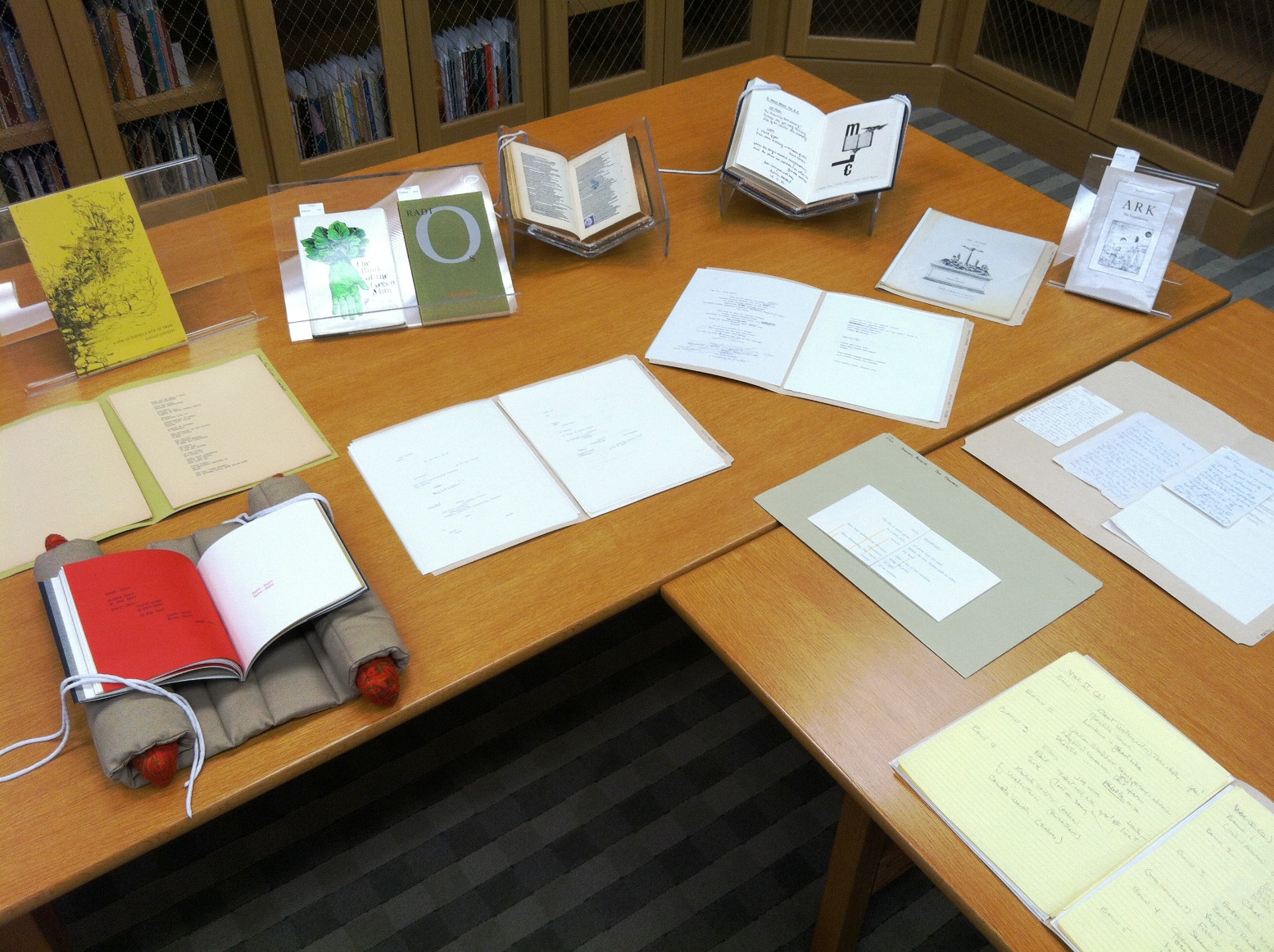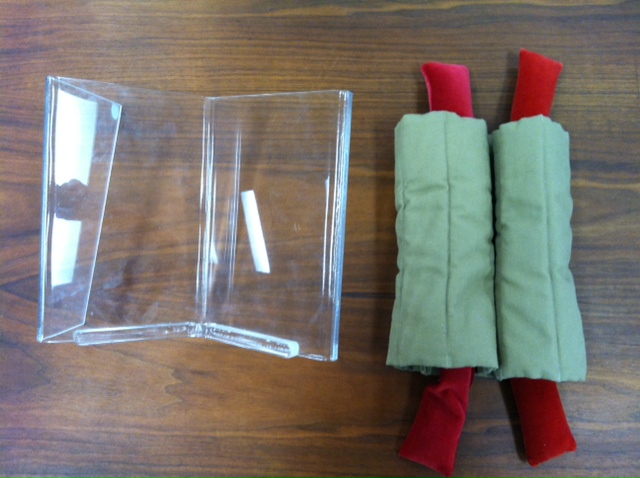Meet the KSRL Staff: Meredith Huff
May 3rd, 2013This is the first in what will be a recurring series of posts introducing readers to the staff of the Kenneth Spencer Research Library. Meredith Huff is Spencer’s Building Operations and Stacks Manager.
Meredith Huff in Spencer’s Marilyn Stokstad Reading Room.
Where are you from?
Battle Creek, Michigan
What does your job at Spencer entail?
I’m the Building Operations Manager, Stacks Manager and Public Services Student Supervisor. I manage the closed stacks and building space, keep track of the collections as they are used, find space for new collections, schedule and find projects for our Public Services Student Assistants.
How did you come to work in special collections and archives?
My first job was shelving books at Willard Public Library in Battle Creek, Michigan. I can still give you Dewey call numbers for some subjects that I shelved regularly. I worked there through high school and community college. When I transferred to Michigan State, where I earned a degree in Horticulture, I worked in the greenhouses as well as at the main library (in the copy center and at the reserve reading desk).
In 2007, I found myself looking for a full-time job that I would enjoy. I had tried out a few jobs since college, but never really found a job with the daily variety and challenge that I enjoyed. I wasn’t ready to jump into entrepreneurship just yet. I had always enjoyed my work in libraries and bookstores. Books aren’t too different from plants; in fact, books are made of plants. Care and handling of delicate plants can’t be too different from care and handling of rare books and manuscripts, I thought. So I redesigned my resume to highlight my library experience and skills, and began applying for library work. My husband and I had lived in Kansas for a short-time in 2006, and we knew we liked the area.
I found my current position advertised on the KU jobs site and applied. Early in August 2007, I was called for a phone interview. I had done some research on Kenneth Spencer Research Library, and knew it would be unlike any other library where I’d worked, so I knew I would be challenged in my work. I began working at KSRL on October 1, 2007. Each day since has been different.
What is the strangest item you’ve come across in Spencer’s collections?
I don’t spend much time looking at our collection items specifically. I’m always focused on the call numbers. Occasionally, I’ll hear about interesting items from my students or curators. Someone was in recently researching chocolate. A student paged something from our Special Collections stacks which turned out to be two pieces of Brach’s Huck Finn Chocolate Candy [editor’s note: safely encapsulated in an air-tight housing to prevent pests!]. I’m not sure how old the chocolates were. Another student, working on a project, found a few books in Special Collections which had hair inside, something that people rarely collect nowadays. We’ve got some other really cool things from a moon rock (RH MS 167 VLT) to uranium from the Manhattan Project (RG 17/22) to ancient manuscripts and cuneiform tablets (MS Q4).
As Stacks Manager, you are the expert at locating anything that isn’t where it should be in Spencer’s stacks. What’s the secret to tracking down such items?
I’ve always been good at finding things. When I was younger, if my family couldn’t find something, they’d offer me five bucks to find it and I usually could. Once my dad had hidden all his credit cards before my parents left for an anniversary trip. I was offered five bucks, my going rate, to find them while they were in Chicago for the weekend. I spent the weekend searching. While doing so, I tried to think about what my dad would have thought would be a ‘good hiding spot.’ I spent hours searching the kitchen, then upstairs to their bedroom, back down to check the dining room, back upstairs to check clothes pockets in their closet, then back down to check the coat closets, my Dad’s desk drawers and cubby hole. I even checked odd places in the basement.
Determined to find them, I began going through my dad’s books–book by book, bookcase by bookcase. I can still remember which book I finally found them in. After exhausting every nook and cranny of the house, I decided to have my dad follow my search to find the cards himself. So I sent him on a scavenger hunt throughout the house, leaving clues leading him to each place I had searched. Finally the last clue used a riddle to lead him to the book where he had hidden the credit cards. They had been in Sombrero Fallout: A Japanese Novel by Richard Brautigan. I must say, I earned those five bucks.
I enjoy puzzles, solving mysteries, so tracking down something that is misplaced or that others can’t find is fun to me. I’ve got my own mental checklist of areas to search, starting with where the item should be located and “Meredith’s Mystery Shelving” (a book truck the student assistants put items they don’t know where to reshelve). Then I move onto other possible places. With shelving dyslexia (which can occur when a student has been shelving numerous items or is very tired) the call numbers start to get jumbled, so I try to think of various combinations of the call number. Was it shelved as a manuscript and not a printed book? Did it get shelved with the photographs instead of the manuscript boxes? Once, I’ve exhausted my simple searches, I go back to my office to search our wonderful new program, Aeon, which manages paging requests and circulation. Who was the last person to ask for this item? What else was paged for that person? Could the item be misshelved with those items? Are there notes in Aeon indicating the item was sent to preservation or processing?
Usually by answering the above questions, I can place my hands on the item or identify its current whereabouts. Having the new Aeon program has really helped me locate items much faster.
Shelving Sleuth: Meredith tracking down incorrectly shelved items at her Mystery Shelving book truck
What part of your job do you like best?
The thing about my job that I like best is that each day is different. I have a variety of tasks and projects to accomplish, and I’m able to approach them as best I can given the daily priorities.
You supervise Spencer’s public services student assistants. What have you learned from working with them?
Working with students, I’ve learned that kids nowadays are much more advanced electronically than those of us who were born in the 70s and grew up in the 80s. They have always had electronics and computers. Most of the time, I don’t really feel much older than the students, but when it comes to the learning curve of new programs or electronics, I begin to feel old, especially when I realize most of the kids weren’t even alive in the 80s.
What are your favorite pastimes outside of work?
I enjoy spending time outdoors. Growing up in Michigan, I’ve canoed, hiked, or backpacked along many of the major rivers. The Manistee area is one of my favorites.
My college degree is in Horticulture, so I love gardening and have worked at an Herb and Flower Farm, a retail greenhouse, and at a landscape maintenance company. Someday I’d like to have my own farm business.Working at the Herb and Flower Farm, I was able to experiment with floral designs and cultivate skills such as bow making.
If I’m not outside with my dogs getting dirty, I’m inside experimenting in the kitchen. I’ve been working on various canning recipes, trying to broaden my skills at preserving my harvest or farmer’s market finds. I enjoy baking homemade bread too. I dabble with sewing and knitting, usually my wintertime pastime. I enjoy reading, mostly, non-fiction (on the history of food, plants, or other aspects of society), biographies, and novels every so often.
What piece of advice would you offer a researcher walking into Spencer Research Library for the first time?
Don’t be afraid to come in and ask for assistance. Let us know it’s your first time; we’re happy to explain why we are a closed stacks library. We’ve got so much cool stuff!! You’ll have an opportunity to work one-on-one with a librarian, and librarians are wonderful founts of knowledge.
Meredith Huff
Building Operations and Stacks Manager, Public Services Student Assistant Supervisor











